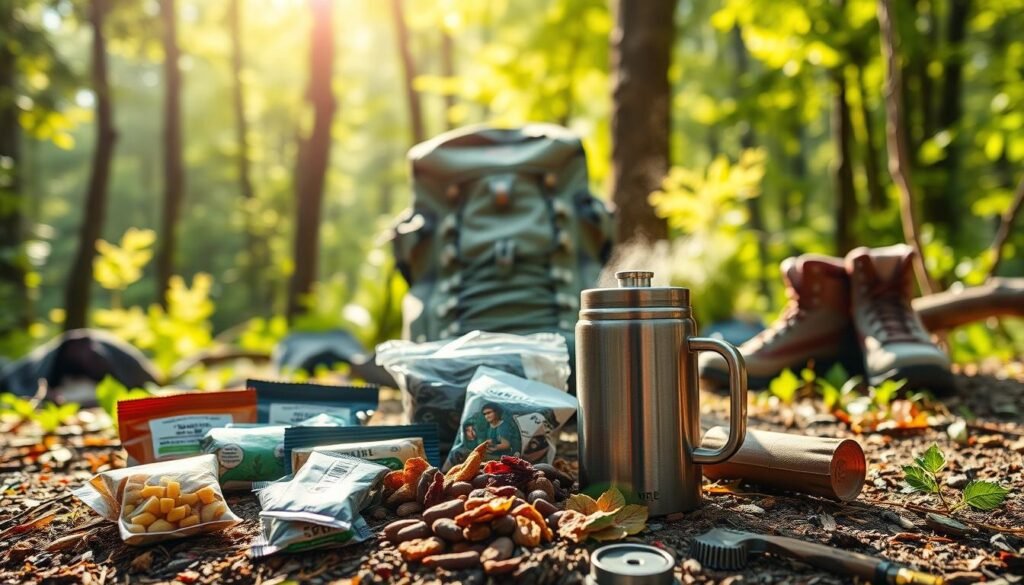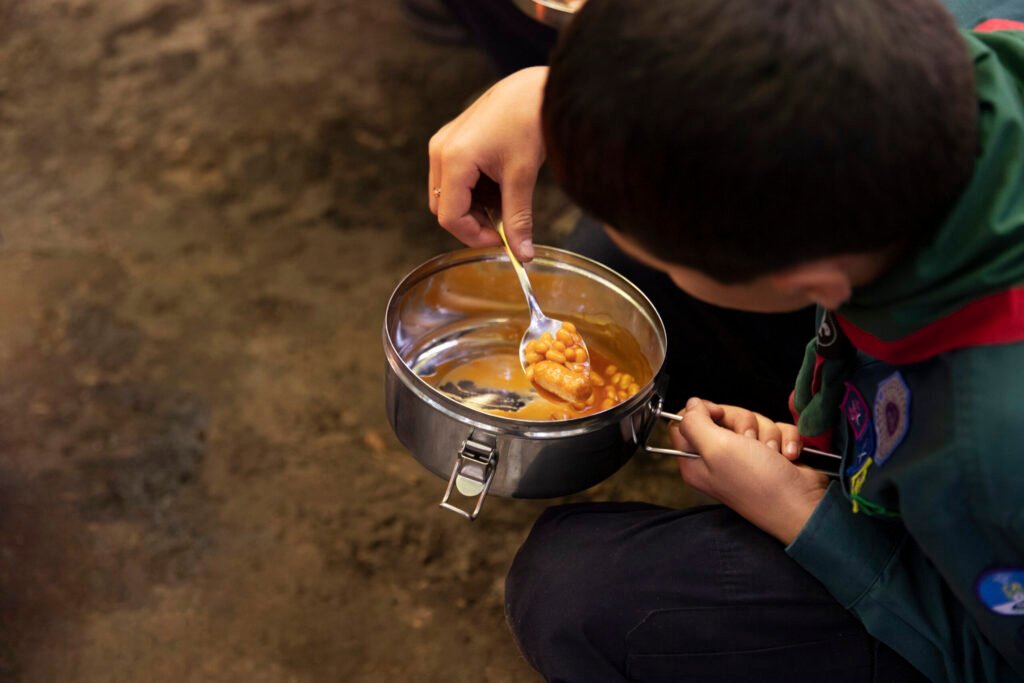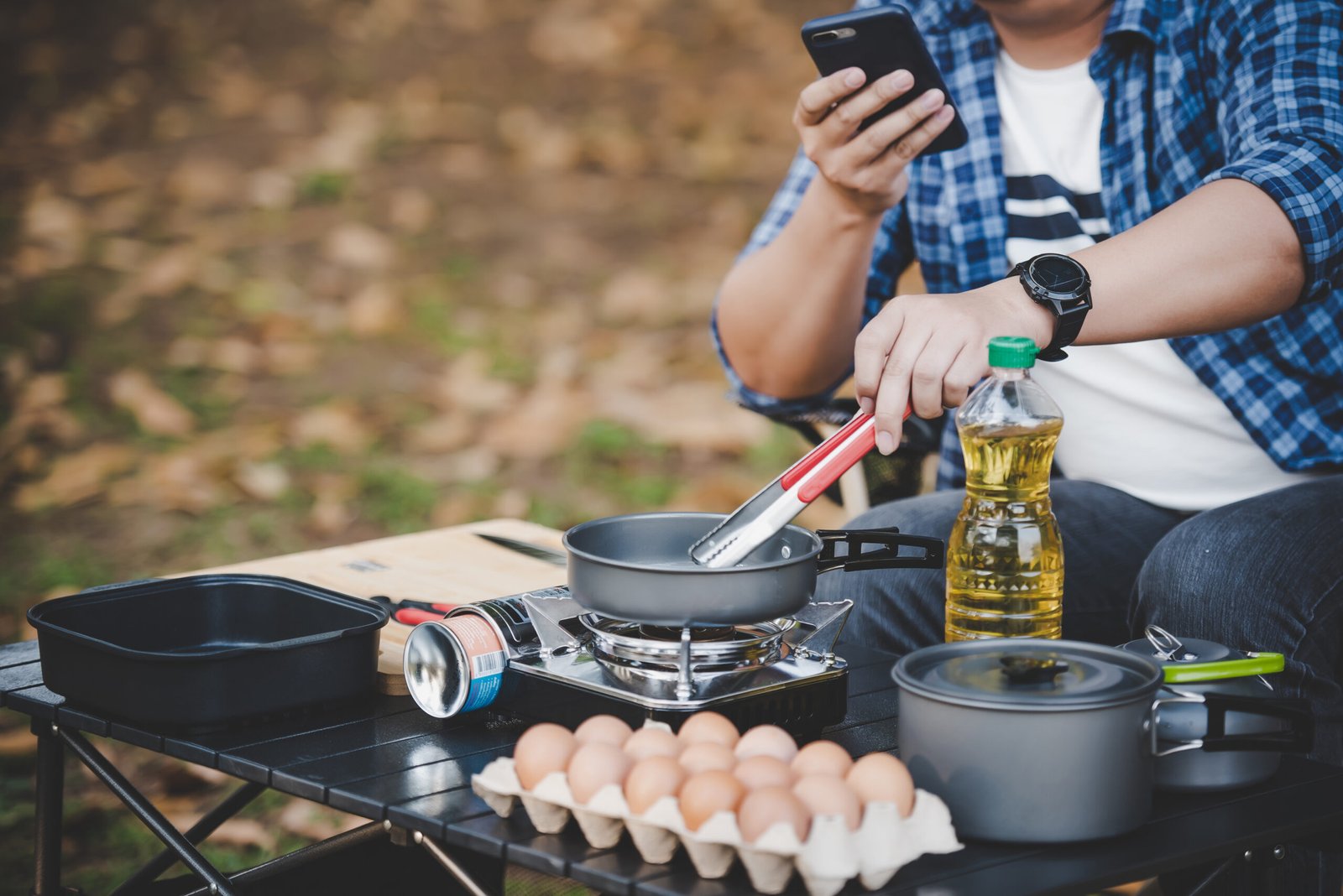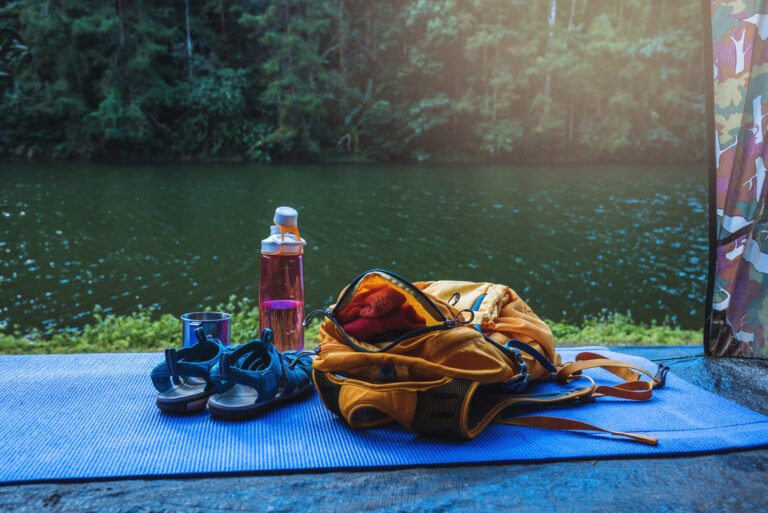Hiker’s Kitchen Alchemy: The Unexpected Food Combinations Creating Perfect Trail Nutrition
Discover unexpected food combinations that fuel your hikes with perfect trail nutrition.
Can the right mix of ingredients transform a mundane hike into an exhilarating adventure? For hikers, understanding the alchemy of hiking nutrition is crucial. It’s not just about packing any food; it’s about creating the perfect blend to fuel your journey.
According to Lori Fish Bard, author of “Eating for Energy: 10 Ways to Boost Your Energy and Stay That Way,” comprehending the role of nutrition in energy production is vital. The right food combinations can significantly enhance trail nutrition, providing the energy needed for a successful hike.

As hikers explore the great outdoors, the importance of optimal hiking nutrition cannot be overstated. It’s about finding the perfect balance to keep you going, whether you’re trekking through mountains or navigating through forests.
The Science Behind Hiking Metabolism and Energy Needs
Hiking significantly impacts your body’s metabolic rate, necessitating a tailored nutritional approach. When engaging in hiking activities, understanding how your metabolism changes is crucial for maintaining optimal energy levels.
How Hiking Changes Your Nutritional Requirements
Hiking alters your nutritional needs due to the increased energy expenditure. The intensity and duration of hikes dictate the type and amount of nutrients required.
For instance, longer hikes require more carbohydrates for sustained energy, while protein becomes essential for muscle repair.
The Perfect Macronutrient Balance for Different Trail Intensities
The ideal macronutrient balance varies with trail intensity. For low-intensity hikes, a balanced diet with moderate carbohydrates and protein suffices.
However, high-intensity hikes demand a higher carbohydrate intake to replenish glycogen stores.
| Trail Intensity | Carbohydrates | Protein | Fats |
|---|---|---|---|
| Low | 40% | 30% | 30% |
| Moderate | 55% | 25% | 20% |
| High | 65% | 20% | 15% |
Micronutrients That Prevent Fatigue and Injury
Micronutrients play a critical role in preventing fatigue and injury during hiking. Vitamin C and Electrolytes are particularly important for maintaining hydration and reducing muscle cramps.
Iron is another crucial micronutrient, as it supports oxygen delivery to muscles, thereby enhancing endurance.
Why Traditional Trail Foods Fall Short on Long Hikes
The limitations of traditional trail foods become starkly apparent on long, demanding hikes. While they may suffice for short excursions, they often fail to provide the sustained energy and nutritional balance required for extended treks.
The Problem with Commercial Energy Bars and Snacks
Commercial energy bars and snacks, though convenient, are often high in processed ingredients and low in essential nutrients. They can cause a quick spike in energy followed by a crash, leaving hikers feeling lethargic. For more insights on better trail nutrition, check out expert tips from backcountry foodies.
Flavor Fatigue: The Hidden Energy Killer
Flavor fatigue is a real issue on long hikes. When trail foods become monotonous, hikers can lose their appetite, leading to inadequate nutrition. Variety is key to maintaining morale and energy levels.
Weight-to-Nutrition Ratio: The Backpacker’s Dilemma
| Food Item | Weight (oz) | Calories |
|---|---|---|
| Dried Fruits | 3 | 300 |
| Nut Butter Packets | 2 | 400 |
| Energy Bars | 4 | 500 |
As shown in the table, the weight-to-nutrition ratio varies significantly among common trail foods. Hikers need to balance weight considerations with nutritional needs.
Sweet and Savory Synergies: Protein-Carb Combinations That Surprise
Trail nutrition isn’t just about calories; it’s about the right synergies between foods. When hikers combine seemingly disparate ingredients, they can create trail food essentials that are both nourishing and delicious.
Nut Butter and Pickle Wraps: The Electrolyte-Protein Powerhouse
Nut butter and pickle wraps might sound unusual, but they offer a potent mix of electrolytes and protein. The creamy texture of nut butter pairs surprisingly well with the tangy, salty flavor of pickles, creating a snack that’s both satisfying and energizing.
- Provides a boost of electrolytes
- Offers sustained energy through protein
- Easy to prepare and pack
Chocolate-Covered Beef Jerky: Instant Energy with Lasting Power
Combining the richness of chocolate with the savory taste of beef jerky creates a snack that’s both indulgent and functional. This pairing offers instant energy from the carbohydrates in chocolate, along with the lasting power of protein from the jerky.
“The combination of flavors and textures can elevate the hiking experience, making mealtime a highlight of the day.”
Parmesan Crisps with Dried Mango: The Umami-Sweet Solution
The umami flavor of parmesan crisps complements the sweetness of dried mango perfectly, creating a snack that’s both complex and refreshing. This combination is not only delicious but also provides a good mix of carbohydrates and protein.
Recipe and Preparation Tips
To make these snacks, start by selecting high-quality ingredients. For nut butter and pickle wraps, use natural nut butter and thinly sliced pickles. For chocolate-covered beef jerky, choose dark chocolate for its antioxidant properties. And for parmesan crisps with dried mango, make your own crisps by baking parmesan cheese in the oven until crispy.
- Prepare ingredients in advance to save time.
- Experiment with different combinations to find your favorite.
- Pack snacks in airtight containers to maintain freshness.
Electrolyte Alchemists: Hydration-Boosting Food Pairings
The right combination of foods can enhance hydration and performance on the trail. As discussed in “Can It & Ferment It” by Stephanie Thurow, hydration and electrolyte balance are crucial for maintaining energy levels during hikes.
Certain food pairings can significantly boost electrolyte levels, providing hikers with the necessary components for optimal hydration. Let’s explore some of these innovative combinations.
Coconut Water Powder with Freeze-Dried Berries
Combining coconut water powder with freeze-dried berries creates a potent hydration-boosting snack. The coconut water powder provides essential electrolytes, while the freeze-dried berries add natural sugars and antioxidants.
Benefits: Replenishes electrolytes, provides natural energy, and supports overall hydration.
Miso Soup Packets with Dried Citrus Zest
Miso soup packets paired with dried citrus zest offer a savory and refreshing hydration solution. The miso soup provides sodium and other electrolytes, while the citrus zest adds a burst of flavor and vitamin C.
As noted by hikers, this combination not only hydrates but also helps to boost morale on long trails.
Olive Oil-Infused Sea Salt for Vegetable Chips
Using olive oil-infused sea salt on vegetable chips is a simple yet effective way to enhance hydration. The sea salt provides essential minerals, while the olive oil adds healthy fats.
This combination is not only delicious but also supports hydration and energy needs.
DIY Electrolyte Mixture Formulas
Creating your own electrolyte mixture can be straightforward. Here’s a simple recipe:
- 2 tablespoons coconut water powder
- 1 tablespoon dried citrus zest
- 1 teaspoon sea salt
- 1/4 teaspoon potassium chloride powder
Mix these ingredients and store them in an airtight container. Use as needed to replenish electrolytes during your hike.
“Proper hydration is not just about drinking water; it’s about maintaining the right balance of electrolytes.”
Ultralight Nutrition Bombs: Calorie-Dense Duos for Long Trails
The key to successful long trail hiking lies in ultralight nutrition bombs. These are high-calorie, nutrient-dense foods that provide the necessary energy without weighing hikers down. When planning nutrition for backpacking, it’s essential to consider the calorie-to-weight ratio of the food.
Dehydrated Avocado and Bacon Bits: 500 Calories in 2 Ounces
Combining dehydrated avocado with crispy bacon bits creates a nutrient-rich snack that’s both filling and lightweight. This duo provides healthy fats, protein, and a burst of flavor, making it an ideal portable snack for long trails.
Tahini-Date Energy Balls with Espresso Powder
Tahini and dates form a powerful energy-boosting combination when mixed with espresso powder. These energy balls are not only rich in calories but also provide a much-needed caffeine boost to keep hikers going.
Powdered Coconut Milk and Seed Mixtures for Instant Puddings
Mixing powdered coconut milk with various seeds like chia or flax creates a nutritious and filling pudding that’s easy to prepare on the trail. This snack is rich in healthy fats and fiber, making it a great trail food essential.
Calorie-to-Weight Ratio Analysis
| Food Combination | Calories per Ounce | Weight (Ounces) | Total Calories |
|---|---|---|---|
| Dehydrated Avocado & Bacon Bits | 250 | 2 | 500 |
| Tahini-Date Energy Balls | 170 | 3 | 510 |
| Powdered Coconut Milk & Seeds | 150 | 4 | 600 |
As shown in the table, these ultralight nutrition bombs offer a high calorie-to-weight ratio, making them perfect for long trail hikes where every ounce counts.
Trail Nutrition Science: Anti-Inflammatory Combinations That Fight Soreness
Trail nutrition science has uncovered innovative anti-inflammatory food combinations that can significantly enhance a hiker’s recovery and performance. These combinations are designed to reduce muscle soreness, a common issue for long-distance hikers.
Turmeric and Black Pepper in Honey Packets: The Science Behind the Pairing
The combination of turmeric and black pepper in honey packets is a potent anti-inflammatory agent. Turmeric contains curcumin, a compound known for its anti-inflammatory properties. However, curcumin’s bioavailability is significantly enhanced when consumed with piperine, found in black pepper, as noted in studies such as those found on PMC. When mixed with honey, this combination not only fights inflammation but also provides a natural source of energy.
Tart Cherry and Dark Chocolate Blends: Recovery Accelerators
Tart cherry and dark chocolate blends are another effective anti-inflammatory combination. Tart cherries are rich in anthocyanins, which have been shown to reduce muscle soreness after exercise. Dark chocolate, rich in flavonoids, complements this effect by enhancing blood flow and reducing oxidative stress. Together, they form a recovery-accelerating duo that is both delicious and nutritious.
Ginger-Infused Dried Fruit Leathers with Collagen Peptides
Ginger-infused dried fruit leathers with collagen peptides offer a unique blend of anti-inflammatory benefits and muscle recovery support. Ginger has natural anti-inflammatory properties that can help reduce muscle pain. When combined with collagen peptides, it supports joint health and muscle recovery, making it an ideal snack for hikers.
How These Combinations Support Muscle Recovery
These anti-inflammatory food combinations support muscle recovery by reducing oxidative stress and inflammation. A study on the effects of nutrition on exercise recovery highlights the importance of anti-inflammatory nutrients.
| Food Combination | Anti-Inflammatory Component | Benefit |
|---|---|---|
| Turmeric & Black Pepper in Honey | Curcumin & Piperine | Enhanced Bioavailability & Energy |
| Tart Cherry & Dark Chocolate | Anthocyanins & Flavonoids | Reduced Muscle Soreness & Oxidative Stress |
| Ginger-Infused Dried Fruit with Collagen | Gingerol & Collagen Peptides | Reduced Muscle Pain & Supported Joint Health |
By incorporating these anti-inflammatory food combinations into their trail nutrition, hikers can potentially reduce muscle soreness and enhance their overall hiking experience.
Morning to Night: Time-Specific Food Strategies for All-Day Energy
The key to sustained energy on the trail lies in timing your nutrition correctly. Hikers need to fuel their bodies at strategic times to maximize their performance and endurance. This involves understanding the best food combinations for different times of the day.
Pre-Hike Breakfast Combinations That Prevent Mid-Morning Crashes
Starting the day with the right breakfast is crucial. Complex carbohydrates paired with protein-rich foods can provide a sustained energy release. For instance, oatmeal with nuts and dried fruits is a popular choice among hikers. It’s not just about the calories; the balance of macronutrients is key to preventing mid-morning energy crashes.
Midday Refueling Strategies for Difficult Terrain
When tackling challenging terrain, hikers need snacks that are both calorie-dense and easy to consume on the go. Energy bars made with wholesome ingredients can be a convenient option. Additionally, pairing hydration with electrolyte-rich foods like dried fruits or energy chews can help maintain energy levels.
Evening Recovery Food Pairings That Improve Sleep Quality
After a long day on the trail, recovery nutrition plays a critical role in replenishing energy stores and supporting muscle recovery. Combinations like turmeric and ginger in a warm soup can aid in reducing inflammation. Moreover, including complex carbohydrates with a source of protein can help in promoting better sleep quality.
Timing Your Nutrition for Maximum Performance
Understanding the timing of your meals can significantly impact your hiking performance. Eating a balanced meal 1-3 hours before hiking, followed by regular snacking, can help maintain energy levels. It’s also important to rehydrate regularly and consume electrolyte-rich foods to prevent dehydration.
By adopting these time-specific food strategies, hikers can enjoy sustained energy throughout the day, enhancing their overall hiking experience.
Trail Kitchen Hacks: Preparation and Preservation Methods
Mastering trail kitchen hacks is essential for hikers to optimize their nutrition. These hacks not only enhance the flavor and variety of trail food but also play a crucial role in food preservation and safety.
Vacuum Sealing Techniques for Food Combinations
Vacuum sealing is a simple yet effective method to preserve food freshness and prevent spoilage. By removing air from the packaging, hikers can significantly extend the shelf life of their trail food.
Benefits of Vacuum Sealing:
- Prevents moisture from entering the package
- Reduces the risk of freezer burn
- Keeps food fresh for longer periods
DIY Dehydration Methods Without Expensive Equipment
Dehydrating food is an excellent way to create lightweight, nutrient-rich trail snacks. Hikers can use simple DIY methods to dehydrate food without needing expensive equipment.
Using the Sun: Spread food thinly on a baking sheet or tray and place it in direct sunlight, covering it with a mesh screen to keep insects away.
Bear-Proof and Weather-Resistant Packaging Solutions
Proper packaging is crucial for protecting food from wildlife and harsh weather conditions. Hikers should use bear-proof containers or bags that are also weather-resistant.
| Packaging Type | Features | Benefits |
|---|---|---|
| Bear-Proof Containers | Durable, secure, and wildlife-resistant | Protects food from bears and other wildlife |
| Weather-Resistant Bags | Waterproof, tear-resistant, and lightweight | Keeps food dry and secure in harsh weather |
Food Safety Considerations in Backcountry Conditions
Maintaining food safety is critical in backcountry conditions. Hikers should be aware of the risks of foodborne illnesses and take necessary precautions.
Key Considerations:
- Store food and trash properly
- Avoid cross-contamination
- Keep food at safe temperatures
Seasonal Trail Nutrition: Adapting Combinations for Weather Extremes
Weather extremes demand a shift in hiking nutrition strategies. As hikers face diverse environmental conditions, their nutritional needs change significantly. Adapting trail nutrition to seasonal variations is crucial for maintaining energy, preventing fatigue, and ensuring overall health on the trails.
Cold Weather Calorie Requirements and Warming Food Combinations
In cold weather, the body expends more energy to maintain its core temperature, necessitating an increase in calorie intake. Hikers should focus on warming food combinations that provide sustained energy. For instance, incorporating high-calorie, high-fat foods like nut butters and dried meats can be beneficial. A study highlighted in “Winter’s Wisdom?” by Ruth Doan MacDougall emphasizes the importance of adapting to seasonal changes, including dietary adjustments for cold weather hiking.
Some effective cold-weather food combinations include:
- Dried fruit and nut mixes with a high calorie content
- Energy-dense bars made with ingredients like oats, nuts, and dried fruits
- Instant soups with added protein sources like jerky or dried chicken
| Food Combination | Calories per Serving | Benefits |
|---|---|---|
| Nut Butter and Dried Meat | 500-700 | High in protein and calories for sustained energy |
| Dried Fruit and Nut Mix | 300-500 | Provides a quick energy boost and essential vitamins |
| Instant Soup with Jerky | 400-600 | Offers hydration, protein, and warmth |
Hot Weather Hydration Strategies Beyond Plain Water
In hot weather, hydration becomes a critical concern. While water is essential, it is not enough on its own. Hikers need to replenish lost electrolytes and maintain hydration through a combination of foods and drinks. Coconut water and electrolyte-rich foods can play a significant role in hot weather hydration strategies.
“Hydration in hot weather isn’t just about drinking water; it’s about maintaining the balance of electrolytes and nutrients lost through sweat.”
Some effective hot-weather hydration strategies include:
- Consuming coconut water or sports drinks to replenish electrolytes
- Eating hydrating foods like watermelon and cucumber
- Using electrolyte tablets or powders in drinking water
Shoulder Season Adaptations When Temperature Fluctuates
During the shoulder season, temperatures can fluctuate significantly, requiring hikers to be prepared for both cold and hot conditions. This demands a flexible nutrition plan that can adapt to changing environmental conditions.
How Weather Affects Digestion and Nutrient Absorption
Weather conditions can significantly impact digestion and nutrient absorption. For example, cold weather can slow down digestion, while hot weather can lead to dehydration, affecting nutrient absorption. Understanding these dynamics is crucial for planning trail nutrition.

By adapting trail nutrition to the demands of different seasons and weather conditions, hikers can maintain optimal energy levels, prevent fatigue, and enjoy a safer, more enjoyable hiking experience.
Bringing Wilderness Food Wisdom Into Everyday Life
The principles of trail nutrition can be surprisingly relevant to daily life. By applying the strategies used by hikers and outdoor enthusiasts, individuals can enhance their overall nutrition and well-being. For instance, incorporating protein-carb combinations like nut butter and dried fruit can provide sustained energy throughout the day.
Events like “The Lodge at Woodloch” workshops, which focus on nutrition and wellness, demonstrate the growing interest in holistic approaches to health. By adopting some of the trail-tested nutrition strategies, such as using electrolyte-boosting food pairings or calorie-dense duos, individuals can improve their daily meal planning and preparation.
Outdoor nutrition principles can be applied in various ways, from meal prep to snack planning. By understanding how to balance macronutrients and incorporate anti-inflammatory foods, individuals can take a proactive approach to their health. This approach not only enhances daily energy but also supports long-term well-being, making trail nutrition wisdom a valuable resource for everyday life.




